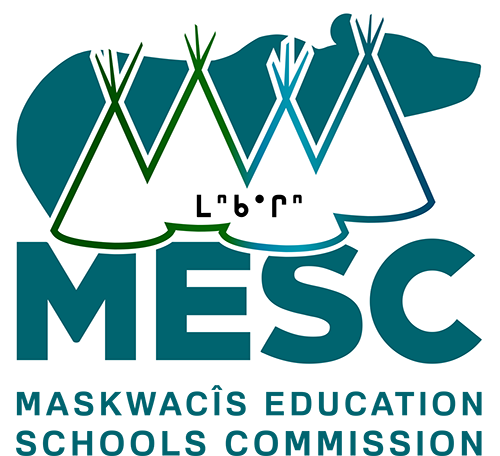Frequently Asked Questions
What is the Maskwacîs Education Schools Commission?
Maskwacîs Education Schools Commission (MESC) began as a collaboration between the education authorities in Maskwacîs in 2013. Originally, “MESC” stood for “Maskwacîs Education Steering Committee”. The purpose of the committee was to examine ways to improve student achievement and develop a Treaty based education authority.
In 2017, Maskwacîs Chiefs and Councils amalgamated the four separate education authorities to create a single education authority for the Maskwacîs Cree. The education authority was developed based on Maskwacîs Cree values and is focused on the needs of students. Extensive consultation, research, planning and negotiations took place leading up to the inception of MESC.
On November 29, 2017, Maskwacîs Education Schools Commission (MESC) was delegated responsibility and authority to operate and maintain all Maskwacîs schools. MESC also manages two headstart programs. The primary goal of MESC is improving educational opportunities, services and student success for all students who attend our schools in Maskwacîs.
Which Nation is in charge of MESC?
MESC is owned & operated by Ermineskin Cree Nation, Louis Bull Tribe, Montana First Nation and Samson Cree Nation through the Maskwacîs Education Law. The law establishes the Maskwacîs Cree Education system and governance structure including:
- The obligations, responsibilities, and powers of the Board of Governors
- The roles of the Board, its officers, the Superintendent and the Director of Finance
- The Wahkohtowin inspired Governance model
The MESC Board of Governors consists of:
- Four (4) Nation representatives (one from each Maskwacîs Nation)
- Two (2) members at large
- Two (2) elders
- Two (2) parent representatives
- The four (4) Maskwacîs Chiefs or their proxy.
The MESC Board of Governors appointments are made through the following processes:
- The Maskwacîs Education Law identifies each Maskwacîs Chief and one Council designate of their choice to sit on the selection committee. That committee selects:
- Four (4) Nation representatives as MESC Board of Governors
- Two (2) members at large (doctorate or expert in their area of expertise) as MESC Board of Governors
- Ten (10) Elders to sit on the Circle of Elders (one male and one female from Ermineskin Cree Nation, Louis Bull Tribe, Montana First Nation, Samson Cree Nation and Pigeon Lake)
- The Circle of Elders selects two (2) Board members from the Circle to sit on the Board of Governors as Elder representatives. This is done through a vote.
- Each MESC school has a parent advisory committee and the Chair of each parent advisory committee forms the Circle of Parents. The Circle of Parents selects two (2) parents to sit on the Board of Governors as parent representatives. This is done through a vote.
- Each Maskwacîs Chief or their proxy have a seat on the MESC Board of Governors as an ex-officio Board Governor.
Who has a say in education planning and development in Maskwacîs?
MESC has created a governance system based on the Cree value of Wâhkôhtowin. This Wâhkôhtowin inspired governance model identifies key rightsholder groups that the MESC Board of Governors is responsible for connecting with. These groups include the Maskwacîs Chiefs and Councils, Elders, students, parents/guardians, Maskwacîs Nation members, and MESC staff through the Superintendent.
This model has provided platforms to engage with over 300 participants annually in a continual conversation on the direction and goals of education. Feedback from these engagements, along with annual performance data, is used in annual school and branch improvement plans.
What is the Maskwacîs Funding Model, and how does it differ from Indigenous Northern Affairs Canada (INAC) funding formulas used previously?
The Maskwacîs Funding Model moved away from the funding policy (Nation-operated school funding formula and proposal-driven grants) to a more stable, flexible and sustainable funding model.
Previously, approximately 65% of the funds Maskwacîs schools received were secured from year to year. The other 35% of those funds way proposal-driven grants and were not guaranteed from year to year.
The Maskwacîs Funding Model secured 100% of the funds for MESC to operate Maskwacîs schools. This funding model is unique to Maskwacîs, and it significantly increases Maskwacîs’ total funding.
What happens when the agreement expires after 10 years?
The term of the MESC Resource and Development Agreement with Canada is 10 years. Eighteen months prior to the expiration of the agreement, both parties will meet to discuss the renewal of the agreement. If both parties do not come to an agreement by the expiration date, the existing agreement will remain in place until both parties come to an agreement. Local control over education in Maskwacîs and funding will not cease.
